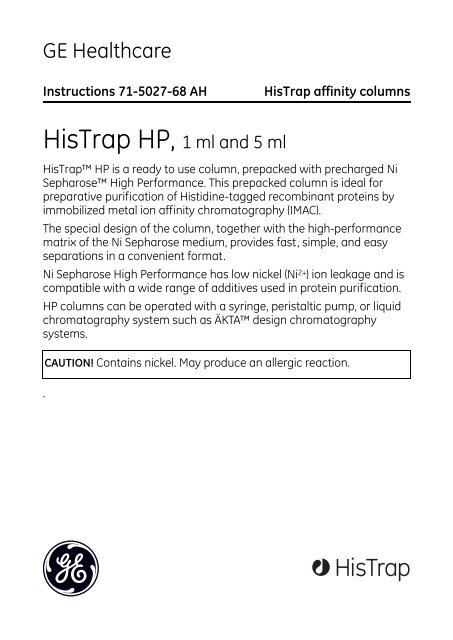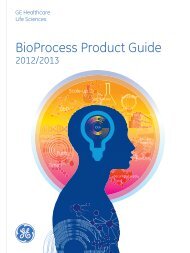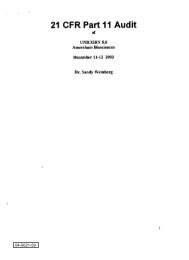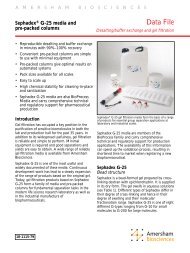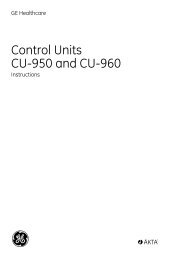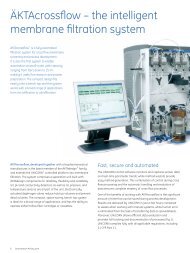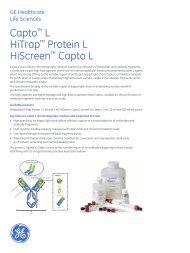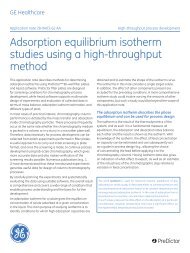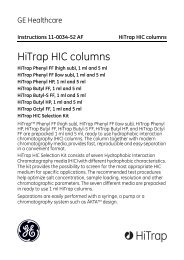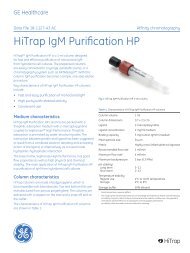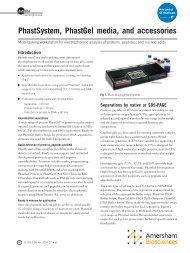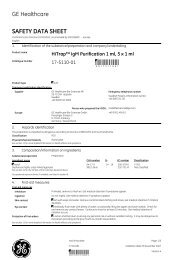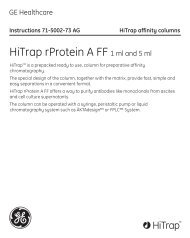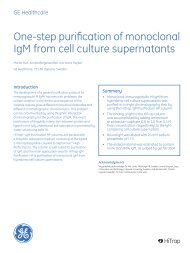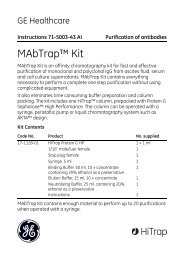HisTrap HP, 1 ml and 5 ml - GE Healthcare Life Sciences
HisTrap HP, 1 ml and 5 ml - GE Healthcare Life Sciences
HisTrap HP, 1 ml and 5 ml - GE Healthcare Life Sciences
Create successful ePaper yourself
Turn your PDF publications into a flip-book with our unique Google optimized e-Paper software.
<strong>GE</strong> <strong>Healthcare</strong><br />
Instructions 71-5027-68 AH <strong>HisTrap</strong> affinity columns<br />
<strong>HisTrap</strong> <strong>HP</strong>, 1 <strong>ml</strong> <strong>and</strong> 5 <strong>ml</strong><br />
<strong>HisTrap</strong> <strong>HP</strong> is a ready to use column, prepacked with precharged Ni<br />
Sepharose High Performance. This prepacked column is ideal for<br />
preparative purification of Histidine-tagged recombinant proteins by<br />
immobilized metal ion affinity chromatography (IMAC).<br />
The special design of the column, together with the high-performance<br />
matrix of the Ni Sepharose medium, provides fast, simple, <strong>and</strong> easy<br />
separations in a convenient format.<br />
Ni Sepharose High Performance has low nickel (Ni2+) ion leakage <strong>and</strong> is<br />
compatible with a wide range of additives used in protein purification.<br />
<strong>HP</strong> columns can be operated with a syringe, peristaltic pump, or liquid<br />
chromatography system such as ÄKTA design chromatography<br />
systems.<br />
CAUTION! Contains nickel. May produce an allergic reaction.<br />
.
Code No. Product No. supplied<br />
17-5247-01 <strong>HisTrap</strong> <strong>HP</strong> 5 × 1 <strong>ml</strong><br />
17-5247-05 <strong>HisTrap</strong> <strong>HP</strong> 100 × 1 <strong>ml</strong> 1<br />
17-5248-01 <strong>HisTrap</strong> <strong>HP</strong> 1 × 5 <strong>ml</strong><br />
17-5248-02 <strong>HisTrap</strong> <strong>HP</strong> 5 × 5 <strong>ml</strong><br />
17-5248-05 <strong>HisTrap</strong> <strong>HP</strong> 100 × 5 <strong>ml</strong> 1<br />
1 Pack size available by special order.<br />
Connector kit<br />
Connectors<br />
supplied<br />
Usage No. supplied<br />
1/16” male/ Connection of syringe to top of 1<br />
luer female HiTrap column<br />
Tubing connector Connection of tubing (e.g. Peristaltic<br />
flangeless/ Pump P1) to bottom of HiTrap<br />
M6 female<br />
column1 1<br />
Tubing connector Connection of tubing (e.g. Peristaltic<br />
flangeless/M6 male Pump P1) to top of HiTrap column2 1<br />
Union 1/16” Connection to original FPLC 1<br />
female/M6 male System through bottom of HiTrap<br />
column<br />
Union M6 female/ Connection to original FPLC System 1<br />
1/16” male through top of HiTrap column<br />
Stop plug female,<br />
1/16”<br />
Sealing bottom of HiTrap column 2, 5 or 7<br />
1 Union 1/16” female/M6 male is also needed.<br />
2 Union M6 female/1/16” male is also needed.<br />
Table of contents<br />
1. Description.............................................................................. 3<br />
2. General considerations..................................................... 6<br />
3. Operation................................................................................. 7<br />
4. Optimization........................................................................ 11<br />
5. Stripping <strong>and</strong> recharging .............................................. 12<br />
6. Cleaning-in-place ............................................................. 13<br />
7. Scaling-up ............................................................................ 13<br />
8. Storage .................................................................................. 14<br />
9. Troubleshooting ................................................................ 14<br />
10. Intended use ....................................................................... 17<br />
11. Ordering Information ...................................................... 18<br />
2 71-5027-68 AH
1 Description<br />
Medium properties<br />
<strong>HisTrap</strong> <strong>HP</strong> 1 <strong>ml</strong> <strong>and</strong> 5 <strong>ml</strong> columns are prepacked with Ni<br />
Sepharose High Performance, which consists of 34 µm highly<br />
cross-linked agarose beads with an immobilized chelating group.<br />
The medium has then been charged with Ni 2+-ions.<br />
Several amino acids, for example histidine, form complexes with<br />
many metal ions. Ni Sepharose High Performance selectively binds<br />
proteins if suitable complex-forming amino acid residues are<br />
exposed on the protein surface.<br />
Additional histidines, such as in the case of (histidine)6 -tag,<br />
increase affinity for Ni 2+ <strong>and</strong> generally make the histidine-tagged<br />
protein the strongest binder among other proteins in for example<br />
an E. coli extract.<br />
Column properties<br />
<strong>HisTrap</strong> <strong>HP</strong> columns are made of biocompatible polypropylene<br />
that does not interact with biomolecules. Columns are delivered<br />
with a stopper on the inlet <strong>and</strong> a snap-off end on the outlet. The<br />
columns have porous top <strong>and</strong> bottom frits that allow high flow<br />
rates. They cannot be opened or refilled.<br />
Columns can be operated with either a syringe <strong>and</strong> the supplied<br />
luer connector, a peristaltic pump, or a chromatography system<br />
such as ÄKTA design.<br />
Note: To prevent leakage, ensure that the connector is tight.<br />
71-5027-68 AH 3
Table 1. <strong>HisTrap</strong> <strong>HP</strong> characteristics.<br />
Matrix Highly cross-linked spherical agarose, 6%<br />
Average particle size 34 µm<br />
Metal ion capacity ~ 15 µmol Ni2+ /<strong>ml</strong> medium<br />
Dynamic binding<br />
capacity1 At least 40 mg (histidine)6-tagged protein/<strong>ml</strong> medium<br />
Column volumes 1 <strong>ml</strong> or 5 <strong>ml</strong><br />
Column dimensions<br />
i.d. × H:<br />
0.7 × 2.5 cm (1 <strong>ml</strong>)<br />
1.6 × 2.5 cm (5 <strong>ml</strong>)<br />
Recommended flow rate 1 <strong>and</strong> 5 <strong>ml</strong>/min for 1 <strong>and</strong> 5 <strong>ml</strong> column respectively<br />
Max. flow rates 4 <strong>and</strong> 20 <strong>ml</strong>/min for 1 <strong>and</strong> 5 <strong>ml</strong> column respectively<br />
Max back pressure2 0.3 MPa, 3 bar<br />
Compatibility during use Stable in all commonly used buffers, reducing<br />
agents, denaturants, <strong>and</strong> detergents (see Table 2)<br />
Chemical stability3 0.01 M HCl, 0.1 M NaOH. Tested for 1 week at 40°C.<br />
1 M NaOH, 70% acetic acid. Tested for 12 hours.<br />
2% SDS. Tested for 1 hour.<br />
30% 2-propanol. Tested for 30 min.<br />
Avoid in buffers Chelating agents, e.g. EDTA, EGTA, citrate<br />
(see Table 2)<br />
pH stability3 short term (at least 2 hours): 2 to 14<br />
long term (≤ 1 week): 3 to 12<br />
Storage 20% ethanol<br />
Storage temperature 4°C to 30°C<br />
1 Dynamic binding capacity conditions:<br />
Sample: 1 mg/<strong>ml</strong> (histidine)6-tagged pure protein (Mr 28 000 or 43 000) in<br />
binding buffer (QB, 10% determination) or (histidine)6-tagged<br />
protein bound from E. coli extract<br />
Column volume: 0.25 <strong>ml</strong> or 1 <strong>ml</strong><br />
Flow rate: 0.25 <strong>ml</strong>/min or 1 <strong>ml</strong>/min<br />
Binding buffer: 20 mM sodium phosphate, 0.5 M NaCl, 5 mM imidazole, pH 7.4<br />
Elution buffer: 20 mM sodium phosphate, 0.5 M NaCl, 0.5 M imidazole, pH 7.4<br />
Note: Dynamic binding capacity is protein-dependent.<br />
2 H2O at room temperature<br />
3 Ni 2+ -stripped medium<br />
4 71-5027-68 AH
The Ni 2+ -charged medium is compatible with all commonly used<br />
aqueous buffers, reducing agents, denaturants such as 6 M Gua-<br />
HCl <strong>and</strong> 8 M urea, <strong>and</strong> a range of other additives (see Table 2).<br />
Table 2. Ni Sepharose High Performance is compatible with the following<br />
compounds, at least at the concentrations given.<br />
Reducing agents1 5 mM DTE<br />
5 mM DTT<br />
20 mM ß-mercaptoethanol<br />
5 mM TCEP<br />
10 mM reduced glutathione<br />
Denaturing agents 8 M urea2 6 M guanidine hydrochloride2 Detergents 2% Triton X-100 (nonionic)<br />
2% Tween 20 (nonionic)<br />
2% NP-40 (nonionic)<br />
2% cholate (anionic)<br />
1% CHAPS (zwitterionic)<br />
Other additives 500 mM imidazole<br />
20% ethanol<br />
50% glycerol<br />
100 mM Na2SO4<br />
1.5 M NaCl<br />
1 mM EDTA3 60 mM citrate3 Buffer substances 50 mM sodium phosphate, pH 7.4<br />
100 mM Tris-HCl, pH 7.4<br />
100 mM Tris-acetate, pH 7.4<br />
100 mM HEPES, pH 7.4<br />
100 mM MOPS, pH 7.4<br />
100 mM sodium acetate, pH 42 1 See Notes <strong>and</strong> blank run, p. 10–11.<br />
2 Tested for 1 week at 40°C.<br />
3 The strong chelator EDTA has been used successfully in some cases, at 1 mM.<br />
Generally, chelating agents should be used with caution (<strong>and</strong> only in the sample, not<br />
the buffers). Any metal-ion stripping may be counteracted by addition of a small<br />
excess of MgCl2 before centrifugation/filtration of the sample. Note that stripping<br />
effects may vary with applied sample volume.<br />
71-5027-68 AH 5
2 General considerations<br />
<strong>HisTrap</strong> <strong>HP</strong> is supplied precharged with Ni 2+ ions. In general, Ni 2+ is<br />
the preferred metal ion for purification of recombinant histidinetagged<br />
proteins. Note, however, that in some cases it may be wise<br />
to test other metal ions, for example Zn 2+ <strong>and</strong> Co 2+, as the strength<br />
of binding depends on the nature of the histidine-tagged protein<br />
as well as the metal ion (see Optimization).<br />
We recommend binding at neutral to slightly alkaline pH (pH 7–8)<br />
in the presence of 0.5–1.0 M NaCl. Sodium phosphate buffers are<br />
often used. Tris-HCl can generally be used, but should be avoided<br />
in cases where the metal-protein affinity is very weak, since it may<br />
reduce binding strength. Avoid chelating agents such as EDTA or<br />
citrate in buffers, see Table 2.<br />
Including salt, for example 0.5–1.0 M NaCl in the buffers <strong>and</strong><br />
samples, eliminates ion-exchange effects but can also have a<br />
marginal effect on the retention of proteins.<br />
Imidazole at low concentrations is commonly used in the binding<br />
<strong>and</strong> the wash buffers to minimize binding of host cell proteins. For<br />
the same reason, it is important to also include imidazole in the<br />
sample (generally, at the same concentration as in the wash<br />
buffer). At somewhat higher concentrations, imidazole may also<br />
decrease the binding of histidine-tagged proteins. The imidazole<br />
concentration must therefore be optimized to ensure the best<br />
balance of high purity (low binding of host cell proteins) <strong>and</strong> high<br />
yield (binding of histidine-tagged target protein). This optimal<br />
concentration is different for different histidine-tagged proteins,<br />
<strong>and</strong> is usually slightly higher for Ni Sepharose High Performance<br />
than for similar IMAC media on the market (see Data File<br />
18-1174-40). Use highly pure imidazole; such imidazole gives<br />
essentially no absorbance at 280 nm.<br />
As alternatives to imidazole elution, histidine-tagged proteins can<br />
be eluted from the medium by several other methods or<br />
combinations of methods – a lowering of pH within the range of<br />
2.5–7.5 can be used, for example. At pH values below 4, metal ions<br />
will be stripped off the medium.<br />
Note: If the proteins are sensitive to low pH, we recommend<br />
collection of the eluted fractions in tubes containing<br />
1 M Tris-HCl, pH 9.0 (60–200 µl/<strong>ml</strong> fraction) to restore the<br />
pH to neutral.<br />
6 71-5027-68 AH
Chelating agents such as EGTA or EDTA will also strip metal ions<br />
from the medium <strong>and</strong> thereby cause protein elution, but the target<br />
protein pool will then contain Ni2+ ions. In this case, Ni2+ ions can be<br />
removed by desalting on a HiTrap Desalting, a PD-10 Desalting<br />
Column, or HiPrep 26/10 Desalting, (see Table 3).<br />
Leakage of Ni2+ from Ni Sepharose High Performance is very low<br />
under all normal conditions, lower than for other IMAC media<br />
tested. For applications where extremely low leakage during<br />
purification is critical, leakage can be even further reduced by<br />
performing a blank run (see page 11). Likewise, a blank run should<br />
also be performed before applying buffers/ samples containing<br />
reducing agents (see page 11).<br />
Whatever conditions are chosen, <strong>HisTrap</strong> <strong>HP</strong> columns can be<br />
operated with a syringe, peristaltic pump, or chromatography<br />
system.<br />
Note: If Peristaltic Pump P-1 is used, the maximum flow rate that<br />
can be run on a <strong>HisTrap</strong> <strong>HP</strong> 1 <strong>ml</strong> column is 3 <strong>ml</strong>/min.<br />
3 Operation<br />
Buffer preparation<br />
Water <strong>and</strong> chemicals used for buffer preparation should be of high<br />
purity. Filter buffers through a 0.22 µm or a 0.45 µm filter before<br />
use.<br />
Use high purity imidazole as this will give very low or no<br />
absorbance at 280 nm.<br />
If the recombinant histidine-tagged protein is expressed as<br />
inclusion bodies, include 6 M Gua-HCl or 8 M urea in all buffers <strong>and</strong><br />
sample. On-column refolding of the denatured protein may be<br />
possible.<br />
71-5027-68 AH 7
Recommended conditions<br />
Binding buffer: 20 mM sodium phosphate, 0.5 M NaCl,<br />
20–40 mM imidazole, pH 7.4 (The optimal<br />
imidazole concentration is proteindependent;<br />
20–40 mM is suitable for many<br />
proteins.)<br />
Elution buffer: 20 mM sodium phosphate, 0.5 M NaCl,<br />
500 mM imidazole, pH 7.4 (The imidazole<br />
concentration required for elution is<br />
protein-dependent).<br />
Sample preparation<br />
For optimal growth, induction, <strong>and</strong> cell lysis conditions for your<br />
recombinant histidine-tagged clones, please refer to established<br />
protocols.<br />
Adjust the sample to the composition <strong>and</strong> pH of the binding buffer<br />
by: Adding buffer, NaCl, imidazole, <strong>and</strong> additives from<br />
concentrated stock solutions; by diluting the sample with binding<br />
buffer; or by buffer exchange, (see Table 3). Do not use strong<br />
bases or acids for pH-adjustment (precipitation risk). Filter the<br />
sample through a 0.22 µm or a 0.45 µm filter <strong>and</strong>/or centrifuge it<br />
immediately before applying it to the column.<br />
To prevent the binding of host cell proteins with exposed histidine,<br />
it is essential to include imidazole at a low concentration in the<br />
sample <strong>and</strong> binding buffer (see Optimization).<br />
8 71-5027-68 AH
Table 3. Prepacked columns for desalting <strong>and</strong> buffer exchange<br />
Comments Application<br />
Elution<br />
volume<br />
Column Code No. Loading<br />
volume<br />
For desalting <strong>and</strong> buffer<br />
exchange of protein<br />
extracts (Mr > 5000).<br />
17-5087-01 2.5–15 <strong>ml</strong> 7.5–20 <strong>ml</strong> Prepacked with<br />
Sephadex G-25 Fine.<br />
Requires a laboratory<br />
pump or a<br />
chromatography system<br />
HiPrep 26/10<br />
Desalting<br />
to run.<br />
17-1408-01 0.25–1.5 <strong>ml</strong> 1.0–2.0 <strong>ml</strong> Prepacked with Sephadex<br />
G-25 Superfine.<br />
Requires a syringe or<br />
pump to run.<br />
HiTrap<br />
Desalting<br />
For desalting, buffer<br />
exchange, <strong>and</strong> cleanup<br />
of proteins <strong>and</strong> other<br />
large biomolecules<br />
(Mr > 5000).<br />
Prepacked with Sephadex<br />
G-25 Medium.<br />
Runs by gravity flow or<br />
centrifugation<br />
3.5 <strong>ml</strong>1 Up to 2.5 <strong>ml</strong>2 17-0851-01 1.0–2.5 <strong>ml</strong>1 1.75–2.5 <strong>ml</strong>2 PD-10<br />
Desalting<br />
1.0 <strong>ml</strong>1 Up to 0.5 <strong>ml</strong>2 28-9180-07 0.1– 0.5 <strong>ml</strong>1 0.2–0.5 <strong>ml</strong>2 PD MiniTrap<br />
G-25<br />
1.5 <strong>ml</strong>1 Up to 1.0 <strong>ml</strong>2 28-9180-08 0.5–1.0 <strong>ml</strong>1 0.75–1.0 <strong>ml</strong>2 PD MidiTrap<br />
G-25<br />
71-5027-68 AH 9<br />
1 Volumes with gravity elution<br />
2 Volumes with centrifugation
Purification<br />
1 Fill the syringe or pump tubing with distilled water. Remove the<br />
stopper <strong>and</strong> connect the column to the syringe (use the luer<br />
connector provided), laboratory pump or chromatography<br />
system tubing “drop-to-drop” to avoid introducing air into the<br />
system.<br />
2 Remove the snap-off end at the column outlet.<br />
3 Wash the column with 3–5 column volumes of distilled water.<br />
4 Equilibrate the column with at least 5 column volumes of<br />
binding buffer. Recommended flow rates are 1 <strong>ml</strong>/min or<br />
5 <strong>ml</strong>/min for the 1 <strong>and</strong> 5 <strong>ml</strong> columns respectively.<br />
In some cases a blank run is recommended before final<br />
equilibration/ sample application (see page 11).<br />
5 Apply the pretreated sample using a syringe or a pump.<br />
6 Wash with binding buffer until the absorbance reaches a<br />
steady baseline (generally, at least 10–15 column volumes).<br />
Note: Purification results are improved by using imidazole in<br />
sample <strong>and</strong> binding buffer (see Optimization).<br />
7 Elute with elution buffer using a one-step or linear gradient.<br />
Five column volumes are usually sufficient if the protein of<br />
interest is eluted by a one-step gradient. A shallow gradient, for<br />
example a linear gradient over 20 column volumes or more,<br />
may separate proteins with similar binding strengths.<br />
Note: If imidazole needs to be removed from the protein, use<br />
HiTrap Desalting, a PD-10 Desalting Column, or HiPrep<br />
26/10 Desalting depending on the sample volume (see<br />
Table 3).<br />
Note: Ni Sepharose High Performance is compatible with<br />
reducing agents. However, removal of any weakly bound<br />
Ni2+ ions by performing a blank run without reducing<br />
agents (as described on page 11) before applying buffer/<br />
sample including reducing agents is recommended. Do not<br />
leave <strong>HisTrap</strong> <strong>HP</strong> columns with buffers including reducing<br />
agents when not in use.<br />
10 71-5027-68 AH
Note: Leakage of Ni2+ from Ni Sepharose High Performance is low<br />
under all normal conditions. The leakage is lower than for<br />
other IMAC media tested (see Data File Ni Sepharose High<br />
Performance, 18-1174-40). For very critical applications,<br />
leakage during purification can be even further diminished<br />
by performing a blank run (as described below) before<br />
loading sample.<br />
Blank run:<br />
Use binding buffer <strong>and</strong> elution buffer without reducing agents.<br />
1 Wash the column with 5 column volumes of distilled water (to<br />
remove the 20% ethanol).<br />
2 Wash with 5 column volumes of elution buffer.<br />
3 Equilibrate with 10 column volumes of binding buffer.<br />
4 Optimization<br />
Imidazole at low concentrations is commonly used in the binding<br />
<strong>and</strong> the wash buffers to minimize binding of host cell proteins. For<br />
the same reason, it is important to also include imidazole in the<br />
sample (generally, at the same concentration as in the wash<br />
buffer). At somewhat higher concentrations, imidazole may also<br />
decrease the binding of histidine-tagged proteins. The imidazole<br />
concentration must therefore be optimized to ensure the best<br />
balance of high purity (low binding of host cell proteins), <strong>and</strong> high<br />
yield (binding of histidine-tagged target protein). This optimal<br />
concentration is different for different histidine-tagged proteins,<br />
<strong>and</strong> is usually slightly higher for Ni Sepharose High Performance<br />
than for similar IMAC media on the market (see Data File Ni<br />
Sepharose High Performance, 18-1174-40). Finding the optimal<br />
imidazole concentration for a specific histidine-tagged protein is a<br />
trial-<strong>and</strong>-error effort, but 20–40 mM in the binding <strong>and</strong> wash<br />
buffers is a good starting point for many proteins. Use a high purity<br />
imidazole, such imidazole gives essentially no absorbance at<br />
280 nm.<br />
Ni 2+ is usually the first choice metal ion for purifying most<br />
(histidine)6-tagged recombinant proteins from nontagged host cell<br />
proteins, <strong>and</strong> also the ion most generally used. Nevertheless, it is<br />
71-5027-68 AH 11
not always possible to predict which metal ion will be best for a<br />
given protein. The strength of binding between a protein <strong>and</strong> a<br />
metal ion is affected by several factors, including the length,<br />
position, <strong>and</strong> exposure of the affinity tag on the protein, the type of<br />
ion used, <strong>and</strong> the pH of buffers, so some proteins may be easier to<br />
purify with ions other than Ni 2+ .<br />
A quick <strong>and</strong> efficient way to test this possibility <strong>and</strong> optimize<br />
separation conditions is to use HiTrap IMAC <strong>HP</strong> 1 <strong>ml</strong> columns,<br />
which are packed with IMAC Sepharose High Performance (not<br />
charged with metal ions). Each column can be charged with<br />
different metal ions, for example Cu 2+, Co 2+, Zn 2+, Ca 2+, or Fe 2+.<br />
Instructions are included with each column.<br />
A study to compare the purification of six (histidine)6-tagged<br />
recombinant proteins, including three variants of maltose-binding<br />
protein, with different metal ions has indicated that Ni 2+ generally<br />
gives best selectivity between (histidine)-tagged <strong>and</strong> nontagged<br />
host-cell proteins (see Application Note 18-1145-18).<br />
5 Stripping <strong>and</strong> recharging<br />
Note: The column does not have to be stripped <strong>and</strong> recharged<br />
between each purification if the same protein is going to be<br />
purified; it is sufficient to strip <strong>and</strong> recharge it after 5–7<br />
purifications, depending on the cell extract, extract volume,<br />
target protein, etc.<br />
Recommended stripping buffer: 20 mM sodium phosphate,<br />
0.5 M NaCl, 50 mM EDTA, pH 7.4<br />
Strip the column by washing with at least 5–10 column volumes of<br />
stripping buffer. Wash with at least 5–10 column volumes of<br />
binding buffer <strong>and</strong> 5–10 column volumes of distilled water before<br />
recharging the column.<br />
Recharge the water-washed column by loading 0.5 <strong>ml</strong> or 2.5 <strong>ml</strong> of<br />
0.1 M NiSO4 in distilled water on <strong>HisTrap</strong> <strong>HP</strong> 1 <strong>ml</strong> <strong>and</strong> 5 <strong>ml</strong> column,<br />
respectively. Salts of other metals, chlorides, or sulfates, may also<br />
be used (see “Optimization”). Wash with 5 column volumes distilled<br />
water, <strong>and</strong> 5 column volumes binding buffer (to adjust pH) before<br />
storage in 20% ethanol.<br />
12 71-5027-68 AH
6 Cleaning-in-place<br />
When an increase in back-pressure is seen, the column can be<br />
cleaned. Before cleaning, strip off Ni2+ ions using the<br />
recommended procedure described above.<br />
After cleaning, store in 20% ethanol (wash with 5 column volumes)<br />
or recharge with Ni2+ prior to storage in ethanol.<br />
The Ni2+ -stripped column can be cleaned by the following<br />
methods;<br />
• Remove ionically bound proteins by washing the column with<br />
several column volumes of 1.5 M NaCl; then wash the column<br />
with approximately 10 column volumes of distilled water.<br />
• Remove precipitated proteins, hydrophobically bound<br />
proteins, <strong>and</strong> lipoproteins by washing the column with 1 M<br />
NaOH, contact time usually 1–2 hours (12 hours or more for<br />
endotoxin removal). Then wash the column with<br />
approximately 10 column volumes of binding buffer, followed<br />
by 5–10 column volumes of distilled water.<br />
• Remove hydrophobically bound proteins, lipoproteins, <strong>and</strong><br />
lipids by washing the column with 5–10 column volumes 30%<br />
isopropanol for about 15–20 minutes. Then wash the column<br />
with approximately 10 column volumes of distilled water.<br />
Alternatively, wash the column with 2 column volumes of<br />
detergent in a basic or acidic solution. Use, for example,<br />
0.1–0.5% nonionic detergent in 0.1 M acetic acid, contact time<br />
1–2 hours. After treatment, always remove residual detergent<br />
by washing with at least 5 column volumes of 70% ethanol.<br />
Then wash the column with approximately 10 column volumes<br />
of distilled water.<br />
7 Scaling-up<br />
Two or three <strong>HisTrap</strong> <strong>HP</strong> 1 <strong>ml</strong> or 5 <strong>ml</strong> columns can be connected in<br />
series for quick scale-up (note that back-pressure will increase).<br />
Ni Sepharose High Performance, the medium prepacked in<br />
<strong>HisTrap</strong> <strong>HP</strong> columns, is supplied preswollen in 25 <strong>and</strong> 100 <strong>ml</strong> lab<br />
71-5027-68 AH 13
packs (see Ordering Information). An alternative scale-up strategy<br />
is thus to pack the medium in empty columns – Tricorn <strong>and</strong> XK<br />
columns are suitable for this purpose.<br />
8 Storage<br />
Store <strong>HisTrap</strong> <strong>HP</strong> columns in 20% ethanol at 4°C to 30°C.<br />
9 Troubleshooting<br />
The following tips may be of assistance. If you have any further<br />
questions about your <strong>HisTrap</strong> <strong>HP</strong> column, please visit<br />
www.gelifesciences.com/hitrap, contact our technical support, or<br />
your local representative.<br />
Note: When using high concentrations of urea or Gua-HCl,<br />
protein unfolding generally takes place. Refolding oncolumn<br />
(or after elution) is protein-dependent.<br />
Tips: To minimize dilution of the sample, solid urea or Gua-HCl can be<br />
added.<br />
Tips: Samples containing urea can be analyzed directly by SDS-PA<strong>GE</strong><br />
whereas samples containing Gua-HCl must be buffer-exchanged<br />
to a buffer with urea before SDS-PA<strong>GE</strong>.<br />
Column has clogged:<br />
• Cell debris in the sample may clog the column. Clean the<br />
column according to the section Cleaning-in-place.<br />
• It is important to centrifuge <strong>and</strong>/or filter the sample through a<br />
0.22 µm or a 0.45 µm filter, see Sample preparation.<br />
Sample is too viscous:<br />
• If the lysate is very viscous due to a high concentration of host<br />
nucleic acid, continue sonication until the viscosity is reduced,<br />
<strong>and</strong>/or add DNase I to 5 µg/<strong>ml</strong>, Mg2+ to 1 mM, <strong>and</strong> incubate on<br />
ice for 10–15 min. Alternatively, draw the lysate through a<br />
syringe needle several times.<br />
14 71-5027-68 AH
Protein is difficult to dissolve or precipitates during<br />
purification:<br />
• The following additives may be used: 2% Triton X-100,<br />
2% Tween 20, 2% NP-40, 2% cholate, 1% CHAPS, 1.5 M NaCl,<br />
50% glycerol, 20 mM ß-mercaptoethanol, 1–3 mM DTT or DTE<br />
(up to 5 mM is possible but depends on the sample <strong>and</strong> the<br />
sample volume), 5 mM TCEP, 10 mM reduced glutathione, 8 M<br />
urea, or 6 M Gua-HCl. Mix gently for 30 min to aid solubilization<br />
of the tagged protein (inclusion bodies may require longer<br />
mixing). Note that Triton X-100 <strong>and</strong> NP-40 (but not Tween)<br />
have a high absorbance at 280 nm. Furthermore, detergents<br />
cannot be easily removed by buffer exchange.<br />
No histidine-tagged protein in the purified fractions:<br />
• Elution conditions are too mild (histidine-tagged protein still<br />
bound: Elute with an increasing imidazole gradient or<br />
decreasing pH to determine the optimal elution conditions.<br />
• Protein has precipitated in the column: For the next<br />
experiment, decrease amount of sample, or decrease protein<br />
concentration by eluting with linear imidazole gradient instead<br />
of imidazole steps. Try detergents or changed NaCl<br />
concentration, or elute under denaturing (unfolding)<br />
conditions (add 4–8 M urea or 4–6 M Gua-HCl).<br />
• Nonspecific hydrophobic or other interaction: Add a<br />
nonionic detergent to the elution buffer (e.g. 0.2% Triton X-100)<br />
or increase the NaCl concentration.<br />
• Concentration of imidazole in the sample <strong>and</strong>/or binding<br />
buffer is too high: The protein is found in the flow-through<br />
material. Decrease the imidazole concentration.<br />
• Histidine-tag may be insufficiently exposed: The protein is<br />
found in the flowthrough material; perform purification of<br />
unfolded protein in urea or Gua-HCl as for inclusion bodies.<br />
• Buffer/sample composition is incorrect: The protein is found<br />
in the flowthrough material. Check pH <strong>and</strong> composition of<br />
sample <strong>and</strong> binding buffer. Ensure that chelating or strong<br />
reducing agents are not present in the sample at too high<br />
concentration, <strong>and</strong> that the concentration of imidazole is not<br />
too high.<br />
71-5027-68 AH 15
SDS-PA<strong>GE</strong> of samples collected during the preparation of the<br />
bacterial lysate may indicate that most of histidine-tagged protein<br />
is located in the centrifugation pellet. Possible causes <strong>and</strong><br />
solutions are:<br />
• Sonication may be insufficient: Cell disruption may be<br />
checked by microscopic examination or monitored by<br />
measuring the release of nucleic acids at A260. Addition of<br />
lysozyme (up to 0.1 volume of a 10 mg/<strong>ml</strong> lysozyme solution in<br />
25 mM Tris-HCl, pH 8.0) prior to sonication may improve<br />
results. Avoid frothing <strong>and</strong> overheating as this may denature<br />
the target protein. Over-sonication can also lead to<br />
copurification of host proteins with the target protein.<br />
• The protein may be insoluble (inclusion bodies): The protein<br />
can usually be solubilized (<strong>and</strong> unfolded) from inclusion bodies<br />
using common denaturants such as 4–6 M Gua-HCl, 4–8 M<br />
urea, or strong detergents. Prepare buffers containing 20 mM<br />
sodium phosphate, 8 M urea, or 6 M Gua-HCl, <strong>and</strong> suitable<br />
imidazole concentrations, pH 7.4–7.6. Buffers with urea should<br />
also include 500 mM NaCl. Use these buffers for sample<br />
preparation, as binding buffer <strong>and</strong> as elution buffer. For<br />
sample preparation <strong>and</strong> binding buffer, use 10–20 mM<br />
imidazole or the concentration selected during optimization<br />
trials (including urea or Gua-HCl).<br />
The protein is collected but is not pure (multiple b<strong>and</strong>s<br />
on SDS polyacrylamide gel):<br />
• Partial degradation of tagged protein by proteases: Add<br />
protease inhibitors (use EDTA with caution, see Table 2).<br />
16 71-5027-68 AH
• Contaminants have high affinity for nickel ions: Elute with a<br />
stepwise or linear imidazole gradient to determine optimal<br />
imidazole concentrations to use for binding <strong>and</strong> for wash; add<br />
imidazole to the sample in the same concentration as the<br />
binding buffer. Wash before elution with binding buffer<br />
containing as high concentration of imidazole as possible,<br />
without causing elution of the tagged protein. A shallow<br />
imidazole gradient (20 column volumes or more), may<br />
separate proteins with similar binding strengths. If optimized<br />
conditions do not remove contaminants, further purification<br />
by ion exchange chromotography (HiTrap Q <strong>HP</strong> or<br />
HiTrap SP <strong>HP</strong>) <strong>and</strong>/or gel filtration (Superdex Peptide,<br />
Superdex 75 or Superdex 200) may be necessary.<br />
• Contaminants are associated with tagged proteins: Add<br />
detergent <strong>and</strong>/or reducing agents before sonicating cells.<br />
Increase detergent levels (e.g. up to 2% Triton X-100 or<br />
2% Tween 20), or add glycerol (up to 50%) to the wash buffer<br />
to disrupt nonspecific interactions.<br />
Histidine-tagged protein is eluted during sample<br />
loading/wash:<br />
• Buffer/sample composition is incorrect: Check pH <strong>and</strong><br />
composition of sample <strong>and</strong> binding buffer. Ensure that<br />
chelating or strong reducing agents are not present in the<br />
sample at a too high concentration, <strong>and</strong> that the<br />
concentration of imidazole is not too high.<br />
• Histidine-tag is partially obstructed: Purify under denaturing<br />
conditions (use 4–8 M urea or 4–6 M Gua-HCl).<br />
• Column capacity is exceeded: Join two or three <strong>HisTrap</strong> <strong>HP</strong><br />
1 <strong>ml</strong> columns together or change to a <strong>HisTrap</strong> <strong>HP</strong> 5 <strong>ml</strong> column.<br />
10 Intended use<br />
The <strong>HisTrap</strong> <strong>HP</strong> is intended for research use only, <strong>and</strong> shall not be<br />
used in any clinical or in vitro procedures for diagnostic purposes.<br />
71-5027-68 AH 17
11 Ordering Information<br />
Product No. supplied Code No.<br />
<strong>HisTrap</strong> <strong>HP</strong> 5 × 1 <strong>ml</strong> 17-5247-01<br />
100 × 1 <strong>ml</strong>1 17-5247-05<br />
1 × 5 <strong>ml</strong> 17-5248-01<br />
5 × 5 <strong>ml</strong> 17-5248-02<br />
100 × 5 <strong>ml</strong>1 17-5248-05<br />
Related products No. supplied Code No.<br />
Ni Sepharose High Performance 25 <strong>ml</strong> 17-5268-01<br />
100 <strong>ml</strong> 17-5268-02<br />
HiTrap Desalting 5 × 5 <strong>ml</strong> 17-1408-01<br />
100 × 5 <strong>ml</strong>1 11-0003-29<br />
PD-10 Desalting Column 30 17-0851-01<br />
HiPrep 26/10 Desalting 1 × 53 <strong>ml</strong> 17-5087-01<br />
4 × 53 <strong>ml</strong> 17-5087-02<br />
<strong>HisTrap</strong> FF 5 × 1 <strong>ml</strong> 17-5319-01<br />
100 × 1 <strong>ml</strong>1 17-5319-02<br />
5 × 5 <strong>ml</strong> 17-5255-01<br />
100 × 5 <strong>ml</strong>1 17-5255-02<br />
<strong>HisTrap</strong> FF crude 5 × 1 <strong>ml</strong> 11-0004-58<br />
100 × 1 <strong>ml</strong>1 11-0004-59<br />
5 × 5 <strong>ml</strong> 17-5286-01<br />
100 × 5 <strong>ml</strong>1 17-5286-02<br />
<strong>HisTrap</strong> FF crude Kit 1 kit 28-4014-77<br />
HisPrep FF 16/10 1 × 20 <strong>ml</strong> 28-9365-51<br />
1 Pack size available by special order.<br />
18 71-5027-68 AH
Accessories No. Supplied Code No.<br />
1/16” male/luer female1 2 18-1112-51<br />
Tubing connector flangeless/M6 female1 2 18-1003-68<br />
Tubing connector flangeless/M6 male1 2 18-1017-98<br />
Union 1/16” female/M6 male1 6 18-1112-57<br />
Union M6 female /1/16” male1 5 18-3858-01<br />
Union luerlock female/M6 female 2 18-1027-12<br />
HiTrap/HiPrep, 1/16” male connector for<br />
ÄKTA design<br />
8 28-4010-81<br />
Stop plug female, 1/16” 2 5 11-0004-64<br />
Fingertight stop plug, 1/16” 3 5 11-0003-55<br />
1 One connector included in each HiTrap package.<br />
2 Two, five, or seven stop plugs female included in HiTrap packages depending<br />
on the product.<br />
3 One fingertight stop plug is connected to the top of each HiTrap column at delivery.<br />
Related literature Code No.<br />
Recombinant Protein Purification H<strong>and</strong>book,<br />
18-1142-75<br />
Principles <strong>and</strong> Methods<br />
Affinity Chromatography H<strong>and</strong>book,<br />
18-1022-29<br />
Principles <strong>and</strong> Methods<br />
Affinity Chromatography, Columns <strong>and</strong><br />
18-1121-86<br />
Media Selection Guide<br />
Ni Sepharose <strong>and</strong> IMAC Sepharose,<br />
28-4070-92<br />
Selection Guide<br />
HiTrap Column Guide 18-1129-81<br />
71-5027-68 AH 19
For local office contact information, visit:<br />
www.gelifesciences.com/contact<br />
<strong>GE</strong> <strong>Healthcare</strong> Bio-<strong>Sciences</strong> AB<br />
Björkgatan 30<br />
751 84 Uppsala<br />
Sweden<br />
www.gelifesciences.com/hitrap<br />
www.gelifesciences.com/protein-purification<br />
<strong>GE</strong> <strong>Healthcare</strong> Europe GmbH<br />
Munzinger Strasse 5,<br />
D-79111 Freiburg,<br />
Germany<br />
<strong>GE</strong> <strong>Healthcare</strong> UK Ltd<br />
Amersham Place<br />
Little Chalfont<br />
Buckinghamshire, <strong>HP</strong>7 9NA<br />
UK<br />
<strong>GE</strong> <strong>Healthcare</strong> Bio-<strong>Sciences</strong> Corp<br />
800 Centennial Avenue<br />
P.O. Box 1327<br />
Piscataway, NJ 08855-1327<br />
USA<br />
<strong>GE</strong> <strong>Healthcare</strong> Bio-<strong>Sciences</strong> KK<br />
Sanken Bldg.<br />
3-25-1, Hyakunincho<br />
Shinjuku-ku, Tokyo 169-0073<br />
Japan<br />
<strong>GE</strong>, imagination at work <strong>and</strong> <strong>GE</strong> monogram are trademarks of General Electric Company.<br />
ÄKTA, Drop Design, HiPrep, HisPrep, <strong>HisTrap</strong>, HiTrap, MidiTrap, MiniTrap, Sephadex, Sepharose,<br />
Superdex, <strong>and</strong> Tricorn are trademarks of <strong>GE</strong> <strong>Healthcare</strong> companies.<br />
IMAC Sepharose products, Ni Sepharose products <strong>and</strong> Fe Sepharose products. These products<br />
are covered by US patent number 6 623 655 <strong>and</strong> equivalent patents <strong>and</strong> patent applications in<br />
other countries.<br />
IMAC Sepharose products <strong>and</strong> Ni Sepharose products (Histidine-tagged protein purification, Lab<br />
products). Purification <strong>and</strong> preparation of fusion proteins <strong>and</strong> affinity peptides comprising at<br />
least two adjacent histidine residues may require a license under US patent numbers 5,284,933<br />
<strong>and</strong> 5,310,663, <strong>and</strong> equivalent patents <strong>and</strong> patent applications in other countries (assignee:<br />
Hoffman La Roche, Inc).<br />
The Tricorn column <strong>and</strong> components are protected by US design patents USD500856,<br />
USD506261, USD500555, USD495060 <strong>and</strong> their equivalents in other countries.<br />
All third party trademarks are the property of their respective owners.<br />
© 2006-2009 General Electric Company – All rights reserved.<br />
First published Jan. 2006.<br />
All goods <strong>and</strong> services are sold subject to the terms <strong>and</strong> conditions of sale of the company within<br />
<strong>GE</strong> <strong>Healthcare</strong> which supplies them. A copy of these terms <strong>and</strong> conditions is available on request.<br />
Contact your local <strong>GE</strong> <strong>Healthcare</strong> representative for the most current information.<br />
imagination at work<br />
71-5027-68 AH 03/2009


